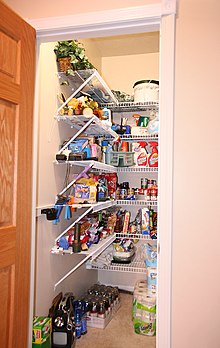Pantry
A pantry is a room or cupboard where beverages, food, (sometimes) dishes, household cleaning products, linens or provisions are stored within a home or office.
There were similar rooms for cooler storage of meats and lard/butter (larder), alcoholic beverages (buttery, known for the "butts", or barrels, stored there), and cooking (kitchen).
By the Victorian era, large houses and estates in Britain maintained the use of separate rooms, each one dedicated to distinct stages of food preparation and cleanup.
[2] Since the scullery was the room with running water with a sink, it was where the messiest food preparation took place, such as cleaning fish and cutting raw meat.
In some middle-class houses, the larder, pantry, and storeroom might simply be large wooden cupboards, each with its exclusive purpose.
The idea is very similar to that of the Hoosier cabinet, with a wide variety of functions being served by specific design innovations.
[citation needed][4] In modern houses, butler's pantries are usually located in transitional spaces between kitchens and dining rooms and are used as staging areas for serving meals.
They commonly contain countertops, as well as storage for candles, serving pieces, table linens, tableware, wine, and other dining room articles.
Breads, butter, cheesecakes, eggs, pastries, and pie were the common food stocks kept in a cold pantry.
With space in the icebox at a premium, the cold pantry was a great place to store fresh berries and fruit.
[citation needed] Chapters of earlier books, particularly written during the era of domestic science and home economics in the latter half of the 19th century, featured how to furnish, keep, and clean a pantry.
This idea did not take hold in American households until a century later, by which time the pantry had become a floor-to-ceiling cabinet in the Post-Vietnam War kitchen[citation needed].
During the Victorian era and until the Second World War, when housing changed considerably, pantries were commonplace in virtually all American homes.




